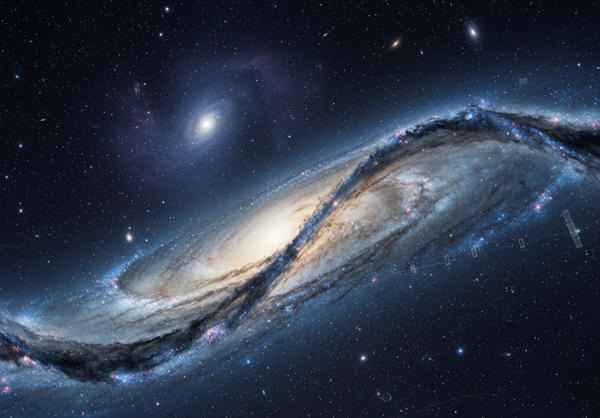The Milky Way’s Hidden Wave: What Is Shaking Our Galaxy?
Our Milky Way galaxy is far from static. It rotates, wobbles, and even warps. But thanks to the European Space Agency’s Gaia space telescope, astronomers have now discovered something even more dramatic: a giant wave rippling across the galaxy’s disk, stretching tens of thousands of light-years.
We’ve long known that stars orbit around the galactic center. By the 1950s, scientists realized that the Milky Way’s disk was warped, and in 2020, Gaia revealed that this disk also wobbles like a spinning top. Now, the latest Gaia data shows an even grander phenomenon—a massive wave stirring the stars across huge swathes of the galaxy.
Mapping the Great Galactic Wave With Gaia
The discovery is beautifully illustrated in Gaia’s new stellar maps. In one view, we look down on the galaxy from above; in another, we slice across it edge-on. These perspectives reveal that the galaxy’s warped disk curves upward on one side and downward on the other.
Overlaying these maps, astronomers found a striking wave pattern of stars. In red, stars sit above the galactic plane; in blue, stars dip below it. This wave is not just visual—it is dynamic. Stars in the wave move in sync, their motions revealed by Gaia’s ability to measure 3D positions and velocities with unprecedented accuracy.
Could it be that the very fabric of our galaxy is rippling like water disturbed by a stone?
Stellar Motions Confirm the Wave-Like Behavior
Eloisa Poggio, astronomer at Italy’s INAF and lead author of the study, emphasizes that Gaia’s strength lies in tracking stellar motions. The data reveal a fascinating pattern: the vertical positions of stars (above or below the disk) are slightly offset from their vertical motions (measured with white arrows on the maps).
This behavior is exactly what one would expect from a true wave. Imagine a stadium crowd doing “the wave.” Some people are standing, some are sitting, and others are just beginning to rise. The Milky Way’s stars show the same frozen moment of wave progression—captured not in seconds, but over cosmic timescales.
Young Stars and Cepheids Carry the Memory of the Wave
To trace this enormous ripple, Poggio’s team studied young giant stars and Cepheid variables. These stars shine brightly across great distances and vary in brightness in predictable cycles, making them excellent markers for Gaia.
The fact that these young stars move with the wave suggests that the galactic gas from which they formed also participates in the ripple. In other words, the wave may be imprinted at birth, as newborn stars inherit the motion of the gas clouds that gave rise to them.
What Is Shaking Our Galaxy?
The cause of this colossal galactic ripple remains a mystery. One possibility is that the Milky Way once collided with a smaller dwarf galaxy, disturbing its disk like a stone tossed into a pond. Another idea links the great wave to the Radcliffe Wave—a smaller filament of gas and stars just 500 light-years from the Sun and extending 9,000 light-years across.
But are these two ripples truly connected, or are they separate echoes of different galactic events?
Poggio cautions that while intriguing, the Radcliffe Wave lies much closer to us and is far smaller than the newly discovered great wave. More research will be needed to understand whether the two structures share a common origin.
The Future of Galactic Cartography With Gaia
The next major milestone for astronomers will be Gaia’s fourth data release, expected to provide even more precise stellar positions and motions, including for variable stars like Cepheids. These refined maps will allow scientists to track the Milky Way’s complex waves with greater clarity—and perhaps uncover the forces shaping them.
As ESA’s Gaia Project Scientist Johannes Sahlmann notes, every new release adds layers to our understanding of the galaxy we call home. With each wave discovered, we are reminded that the Milky Way is not a still, silent structure, but a living, moving system, shaped by events both ancient and ongoing.
A Galaxy in Motion—And in Question
This discovery forces us to rethink the Milky Way’s dynamics. If our galaxy ripples with waves of stars and gas, what does this mean for its past—and its future? Are these motions echoes of ancient collisions, or signs of deeper forces at play in the galactic disk?
Gaia’s discoveries suggest that the Milky Way is more restless and alive than ever imagined. And perhaps the biggest question remains: What great cosmic event set these waves in motion?
Source: The Milky Way’s Hidden Wave: What Is Shaking Our Galaxy?
Earth Just Received Final NASA Laser Message From 218 Million Miles Away
Earth Just Received Final NASA Laser Message From 218 Million Miles Away

